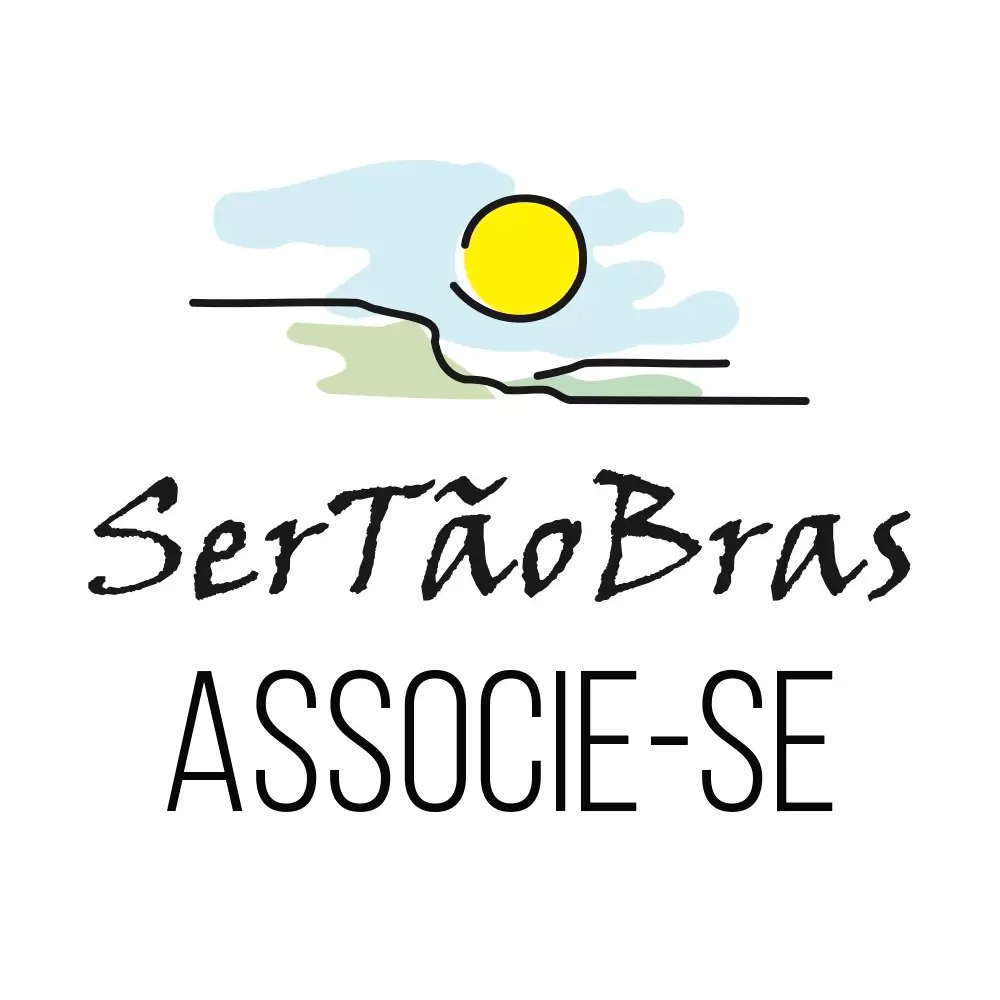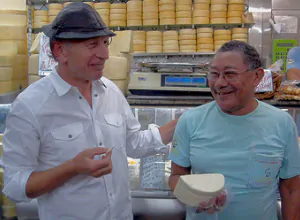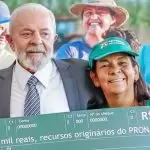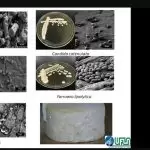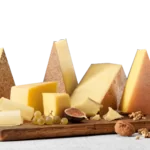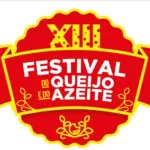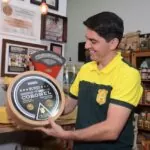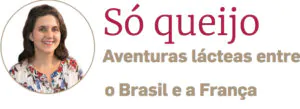May 1st, 2013
By Débora Pereira and Leonardo Dupin
(Read the original article in portuguese)
The wonder below was what British-Australian Will Studd first saw of Serra da Canastra, the heartland of artisanal cheesemaking in Brazil. He was on a visit to appreciate the regional cheeses first hand, and to record one more episode of Cheese Slices, the Australian TV program exploring the growing world interest in raw milk cheeses, to be aired in 2014. Flying over the mountains in a small plane, Will was struck by the natural beauty of the Cerradão Waterfall.
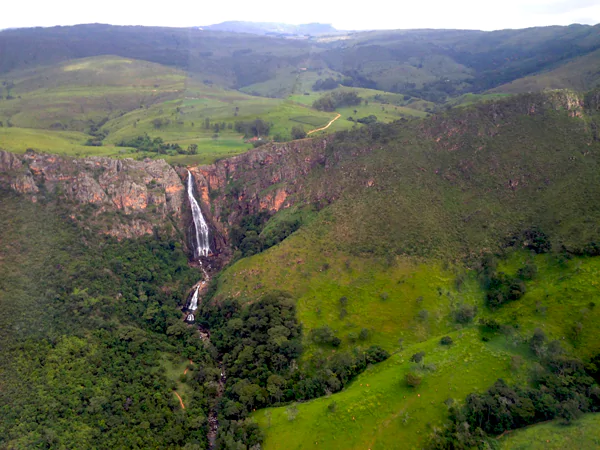
At the source of the Cerradão Waterfall, a privileged site, Otinho and Eliane Freitas produce cheese on their Matinha Farm
Covering the world routes of artisanal cheeses since 2004, Cheese Slices has already visited 27 countries, was translated into 11 languages and watched by 300 million spectators, in over 30 countries. All of which adds to why Will Studd is today one of the most renowned specialists in artisanal cheeses. In Brazil, Studd visited the states of Minas Gerais, Rio Grande do Sul and São Paulo, from April 19th through the 25th.
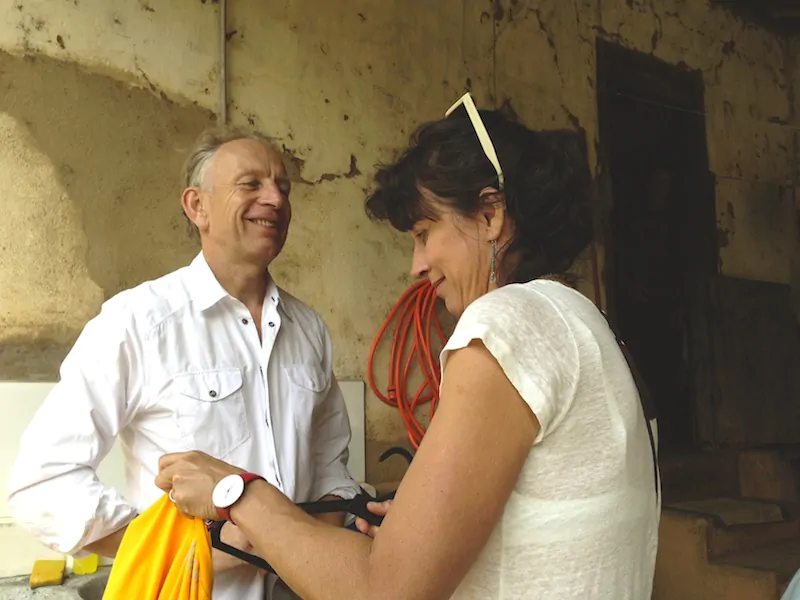
Will is British but has been living since the 80’s in Australia, where he met Bonnie, his wife and collaborator on his trips
At the Central Market in Belo Horizonte, Minas Gerais, the specialist praised the artisanal cheeses he tasted: “Very good. The taste is intense and the medium aged Minas cheese can be very addictive.” About the special aged Canastra Cheese, he said it is at another level, “ It seems another kind of cheese,” he stated.
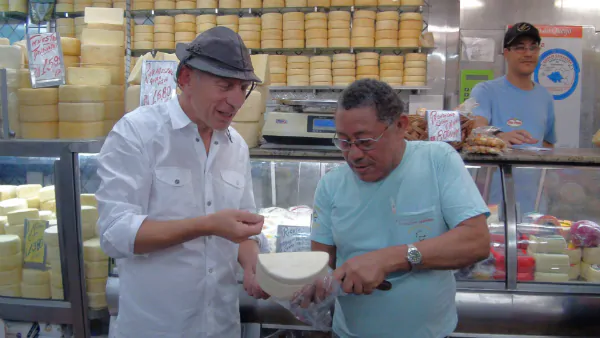
“Once you’ve tasted it, it’s hard to stop eating,” Will said of the medium aged Minas artisanal cheese at the Central Market in Belo Horizonte.
At the Belo Horizonte Museum of Arts and Crafts, the team came to know the history of the traditional Minas cheese, the product of a recipe introduced by the Portuguese during the gold rush and transported on the backs of mules by the “tropeiros”, traders of goods.
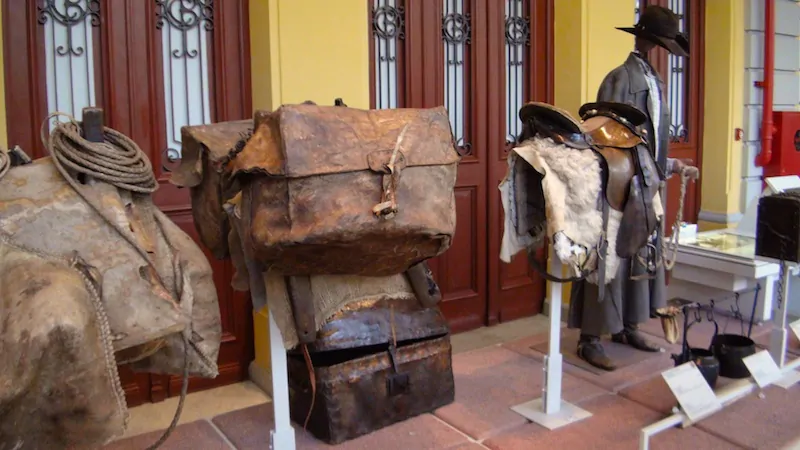
The cheese was transported in “canastras”, square leather bags on show at the Arts and Crafts Museum of Belo Horizonte
In the Canastra Mountains, Studd visited producers from São Roque de Minas and appreciated the tasty local cheeses. What drew his attention was the Canastra Real, a variation of the Canastra that weighs close to 6kgs, or 13 lbs. Only two producers make this cheese today: João Leite in São Roque and Luciano Machado in Medeiros, with different recipes.
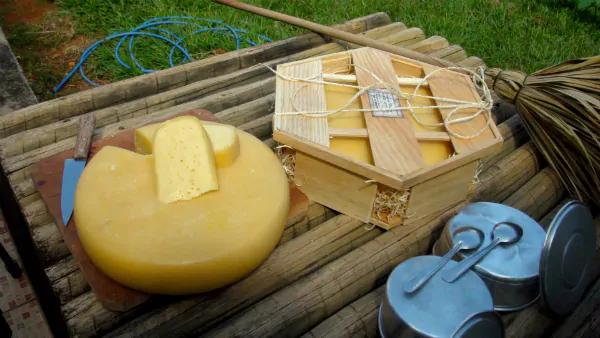
Canastra Real produced by João Leite matures for approximately a month before being commercialized and has holes like the Swiss Emmental
Against the fact that the Brazilian government persists in keeping raw milk cheese on the margins of the law through regulations that cannot be met by small rural producers, Will argues that the Canastra Cheese represents the continuity of a family based agriculture and maintains the region’s identity. He questions the sanitary barriers imposed: “I think consumers have the right to choose and taste raw milk cheeses. Why can’t bureaucrats think of a solution considering the producers and consumers who like raw milk cheese?” he asked.
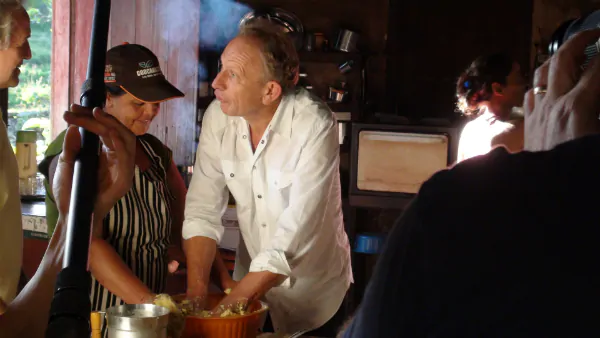
Will gets his hands on the cheese dough made by Romilda, a cheese producer who was in the doc “O Mineiro e o Queijo” (Minas People and their Cheese), by Helvécio Ratton
Colonial and Serrano Cheeses
to Vacaria, where they got to know the Colonial Cheese. From there they proceeded northward to São José dos Ausentes, bordering the State of Santa Catarina, to taste the Serrano Cheese at the highest point in Rio Grande do Sul, the Monte Negro peak.
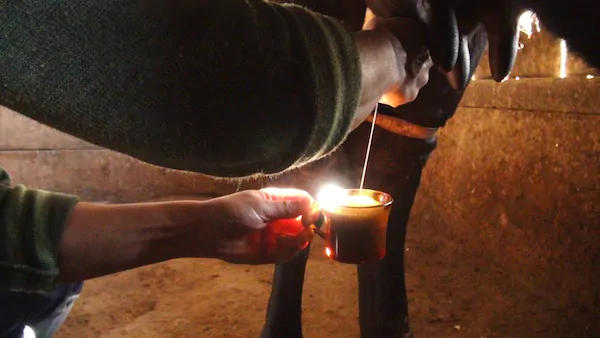
At Antônio and Maria Lopes’ farm, the team enjoyed the Camargo, coffee with milk fresh from the cow
There they watched the making of cheese and of the traditional regional salty biscuit known as cheese pencil, and saw the transport of the product in “bruacas”, leather bags put on the backs of mules that, according to Lopes, can carry up to 45 kgs each. They were also offered the traditional local churrasco (meat barbecue).
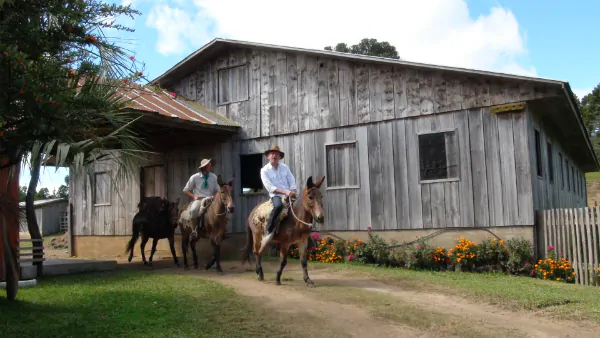
Will Studd leads the way, followed by Eliseu Lopes and the pack mule with cheeses in the “bruacas”
Regarding the South of Brazil, Will Studd said: “It’s a surprising place with a very special way of making cheese. Besides, its Serrano Cheese has a very characteristic taste.”
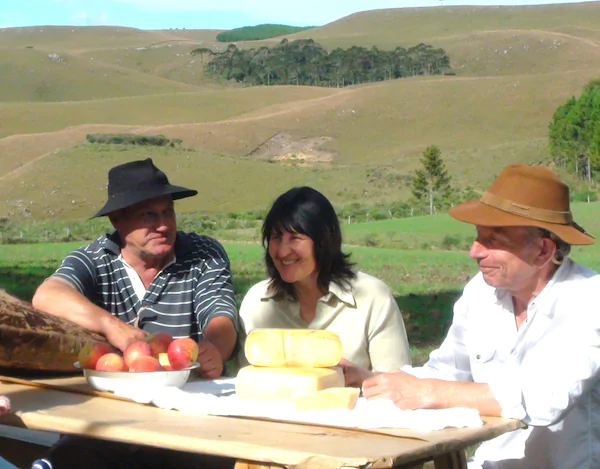
Antonio and Maria Lopes presenting Studd their precious Serrano cheese
Coalho Cheese at the Mocotó Restaurant
In São Paulo, Cheese Slices visited Mocotó Restaurant, which offers Brazilian Northeastern foods, where they watched the making of a Coalho Cheese specialty: small tapioca cubes with Coalho Cheese, baked on the grill, the same as is sold on some Brazilian beaches. “This cheese has a consistent texture and was the only I found in Brazil that can be made from both raw and pasteurized milk. It’s interesting that it is sold on the beaches,” said Will.
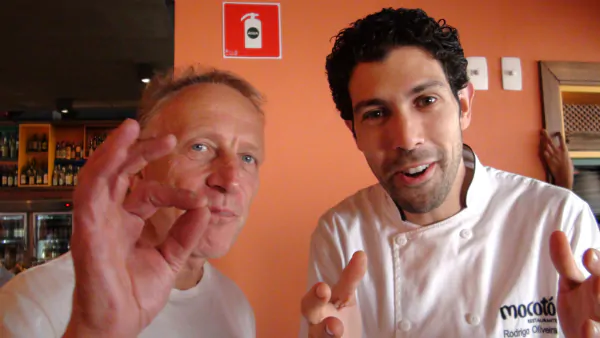
Will Studd approved the cooking of chef Rodrigo Oliveira, at Mocotó Restaurant, which offers Northeastern specialty dishes
On leaving Mocotó, Will wanted to visit the place where Rodrigo Oliveira finds the Coalho Cheese and other Northeastern ingredients. The team ventured along Paulo Afonso St., in Brás, SP, where they bought tobacco and artisanal leather to take back to Australia.
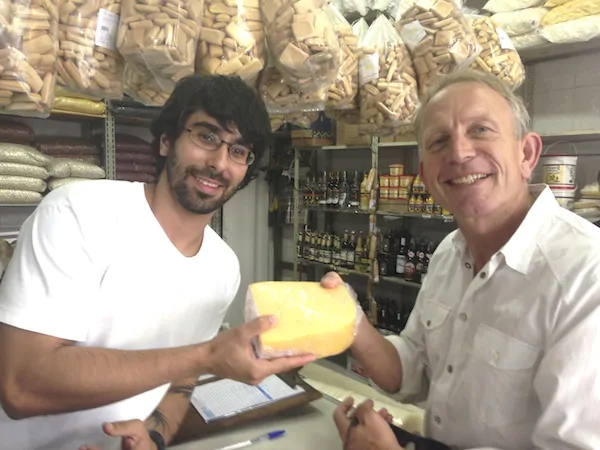
Coalho cheese on the street with Northeastern products in SP
They also visited the first shop specialized in Brazilian artisanal cheeses in SP, A Queijaria, which has a selection of dozens of cheeses from the states of Minas Gerais, Pernambuco, Rio Grande do Sul and São Paulo.
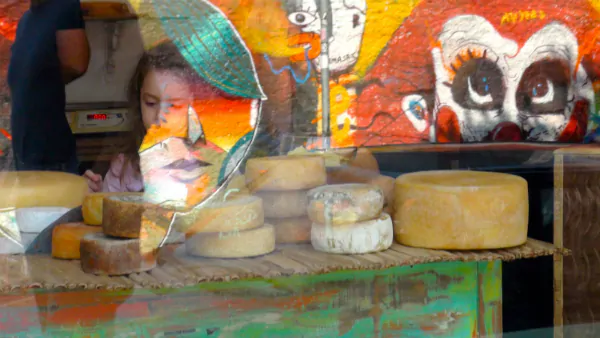
Graffitti, typical in the SP scenario, reflected on the display window of A Queijaria, specialty cheese shop, managed by Fernandto Soares
“I hope the next time I come to Brazil the authorities and producers have found a solution to legalizing the production of raw milk cheese,” said Will at the end of the trip.
Veja abaixo todas as fotos do Cheese Slices Brasil:
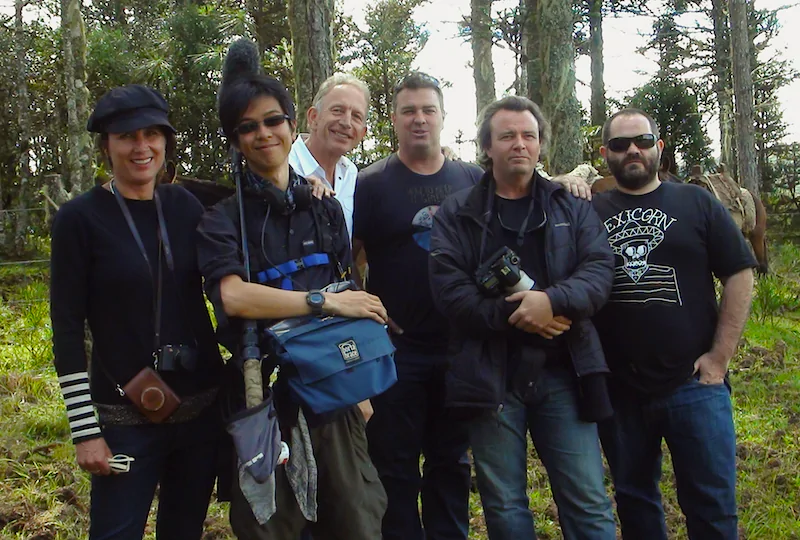
Cheese Slices team: Bonnie Studd, Jonathan Hoong, Will Studd, Roger Price, Michael Robinson e Joaquin Rodriguez, no Monte Negro, Rio Grande do Sul
SerTãoBras collaborators: Aluísio Marques, Ana Massochi, Débora Pereira, Fabrício Porcaz, Gabriel Andrade, George Boyd, Graça Cremon, José Maria Rabelo, Leonardo Dupin, Leôncio Diamante, Li An, Patrícia Rabelo and Rajat Nayyar.
Photos by Li An and Débora Pereira

